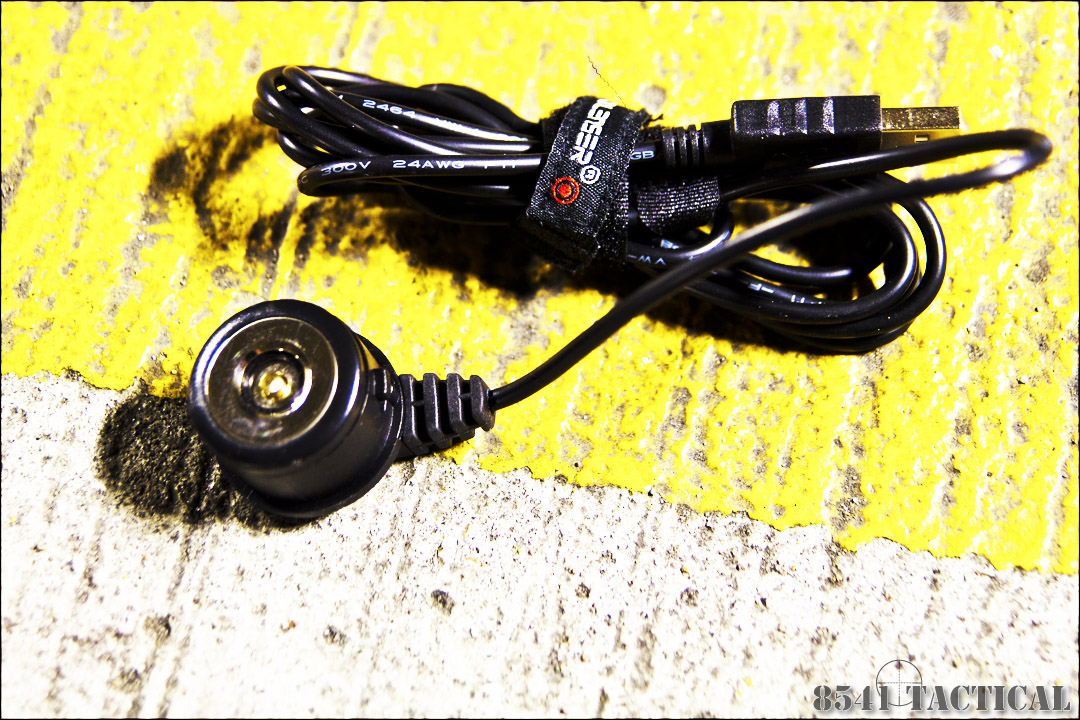When I opened the shipping box my attention was quickly drawn by the hard plastic case of the M7R. It was a simple, black, blow-molded case with a cardboard sleeve around it. Inside the box was a simple manual, battery, charger, bracket, 110v plug, lanyard and the flashlight.

The M7R is advertised as one of LED Lenser's "Full Size" flashlights. It has a black anodized aluminum body. The edges are all smooth and rounded with a nice knurling around the middle. The markings are clearly engraved and it feels good on the hand. The 6" length is about perfect for an "all around/tactical" light. It fills the hand, but still fits easily in a pocket. Our sample was unintentionally skipped across the pavement several times during the evaluation (flipping a flashlight only looks cool until you drop it) and only suffered very minor scuffs to the finish.
The M7R and most of LED Lenser's other lights have a focusable beam. This is nothing new on flashlights, but the way they go about adjusting the beam is rather unique. LED Lenser calls it their "Advanced Focus System". They combined a lens and a reflector into one system to give you a nice tight beam or a even spill on demand. The execution of the system is very simple. You just slide the head forward for a focused beam and back for a flood. The light can be locked in either position by turning the head.
 |
The on/off switch is located on the tailcap of the flashlight. Right out of the box you can click the button to act as an on/off switch or half-press for momentary light. After that you need to dig into the manual for the programming options. The M7R offers you eight "mode" options depending on the program that you have the light set on. The modes available are Morse Code, Boost, Power, Low Power, Dim, Blink, SOS, and Defense Strobe. Output ranges from 27 lumens to 210 lumens and runtime from 20 hours to 11 hours. |
Most professional users will probably leave the light in the "Tactical" program. This mode was what I used for the majority of my evaluation. In this setting when you half-press the button you get a full 210 lumens for as long as you keep the button in. If you press the button until it clicks then you can release it and keep the light on at 210 lumens. If the light is left on for an extended time it will "step down" the output depending on the energy program. While the light is clicked on, a tap on the switch will cause the light to strobe. Tap again and it will go back to constant light. At any time the button can be clicked to turn the light off.
Several other programs are available allowing you to adjust the light output and runtime, but I found that in the other programs you end up fiddling with the light too much. This is not something you want to deal with when you are in a tactical situation. LED Lenser calls this "Smart Light Technology" and it would definitely be in your best interest to RTFM (read the manual) to get the most out of the programming for your specific use. Other programs are accessed by a series of short presses, then a click to "lock" the mode in.
| Charging the M7R is pretty simple, but fairly unique. The included "Floating Charge System" is USB based. You can plug it into your PC, Laptop or whatever you have at hand. If you do not have a USB port available, the system includes a 110V to USB adapter. I really love than manufacturers are going to these type of systems for all types of portable devices. I am down to carrying one 110V to USB adapter to charge my iPhone, camera, flashlight, etc. The really unique part of the system is that the charger is magnetic. It just sticks to the back of the flashlight. The tailcap switch doubles as the contacts for the charger. It is rated at five hours to charge from dead. I never got a chance to run the M7R to full drain, so I can't comment on that time period. I can say that it took me four weeks of regular use to get to a point that I needed to charge the light. Even then I dropped it on the charger in my car at the beginning of my shift (1400hrs) and by the time it was dark, the light on the charger had turned from red to green, indicating a full charge. |
 |
Using the M7R was a joy. Once I understood the programming and programmed my hand on how to manipulate the spot/flood control it was all smooth running. The M7R comes with a plastic belt clip, but I preferred to keep it in the inner pocket in the cargo pocket of my 5.11 TDU's. In regular BDU pants it had the annoying habit of turning sideways. I usually kept the beam locked in the "spot" mode, but it was a very simple matter to put it into flood immediately when needed.
The only drawback I could find to the M7R was that in the "Tactical" Program there is no way to turn it off without strobing for half a second. It really doesn't have any significance, but was a mild annoyance. The final drawback is that the water resistance rating is only "IPX4" this means it's only rated to be used in the rain or take a splash. I would love to at least see a IPX7 rating (immersible).
Keep an eye on our YouTube Channel for the HD Video Review.
Street Price: $110
For more information check out the LED Lenser Website. |


